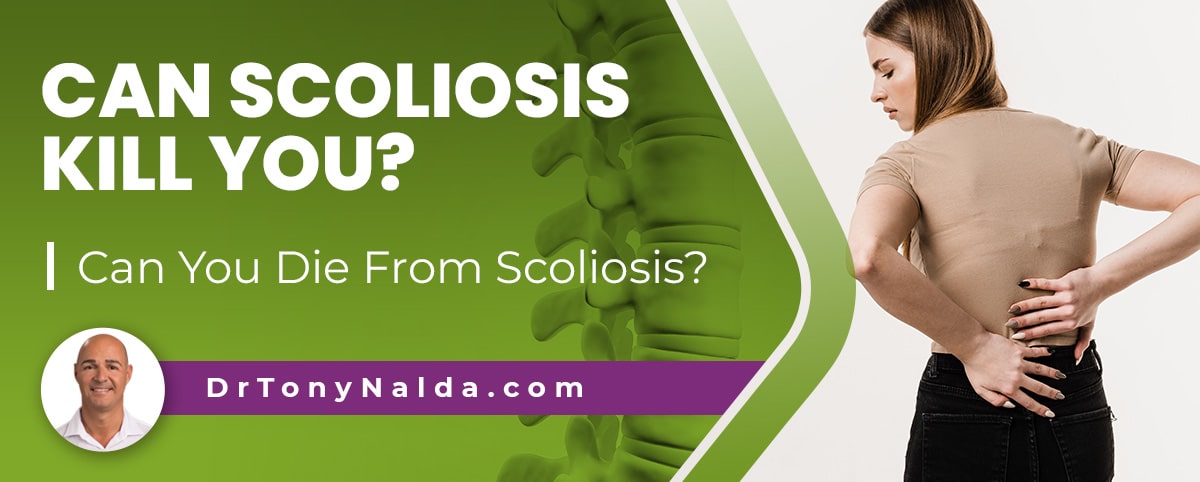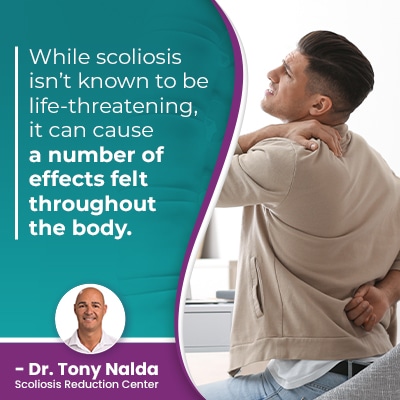Can Scoliosis Kill You? Can You Die From Scoliosis?

It’s natural to wonder just how serious a condition you’ve recently been diagnosed with is, and when it comes to scoliosis, while the condition is progressive, it’s not known as life-threatening. If scoliosis is left untreated, the unnatural spinal curve can increase in size, causing symptoms to escalate, and making the condition more complex to treat; particularly if caught early, scoliosis is highly treatable.
Scoliosis is a structural spinal condition that involves the development of an unnatural spinal curve. On its own, scoliosis isn’t considered a life-threatening condition, but if left untreated, it’s virtually guaranteed to get worse over time.
Scoliosis can affect the body in many different ways, but before getting to the condition’s effects, let’s start with how the condition is diagnosed.
Table of Contents
Diagnosing Scoliosis
The spine’s natural and healthy curves make it stronger, more flexible, and better able to absorb/distribute mechanical stress.
When the spine’s natural curves are in place, this means the vertebrae (bones of the spine) are aligned, and in order for the spine to function optimally, its natural curves and alignment have to be in place.
If the spine loses one or more of its healthy curves, its biomechanics are disrupted, and this can lead to a number of issues and cause a number of symptoms.
While the spine is a key structure, many spinal conditions, although capable of impacting numerous systems and parts of the body, aren’t generally life-threatening.
Being diagnosed with scoliosis means an unnatural sideways spinal curve, that also rotates (twists), has developed.
In addition, the unnatural spinal curve has to be of a minimum size to be diagnosed as a true scoliosis: Cobb angle measurement of at least 10 degrees.
Condition Severity
Condition severity is an important factor that shapes a person’s experience of life with scoliosis, as well as informing the design of effective treatment plans.
A patient’s Cobb angle is determined during X-ray and tells me how far out of alignment a scoliotic spine is, while classifying conditions in terms of severity.
In general, the more severe, the more noticeable the condition’s effects are going to be:
- Mild scoliosis: Cobb angle measurement of between 10 and 25 degrees
- Moderate scoliosis: Cobb angle measurement of between 25 and 40 degrees
- Severe scoliosis: Cobb angle measurement of 40+ degrees
- Very-severe scoliosis: Cobb angle measurement of 80+ degrees
As you can see, the condition ranges widely in severity, and while scoliosis can cause some complications if severe and left untreated, death isn’t one of them.
So now that we’ve defined the condition and discussed the parameters that have to be met in order to reach a diagnosis of scoliosis, let’s talk about how the condition’s effects increase with progression, as this is the true cost of leaving scoliosis untreated.
How Does Scoliosis Affect the Body?
 While scoliosis isn’t known to be life-threatening, it can cause a number of effects felt throughout the body.
While scoliosis isn’t known to be life-threatening, it can cause a number of effects felt throughout the body.
Not only does the spine allow us to remain upright, practice good posture, engage in flexible movement, and protect important organs, it also works in tandem with the brain to form the body’s central nervous system (CNS).
The central nervous system is a complex and vast communication network that facilitates brain-body communication, so the spine is involved in the functioning of virtually every working system within the body.
Scoliosis introduces a lot of uneven forces to the body, not just the spine and its surrounding muscles and nerves.
In children and adolescents, the main symptom of scoliosis is postural deviation, and this is a noticeable condition effect that will get worse if left untreated, but it can’t kill a person.
Postural Deviation and Scoliosis
Due to the uneven forces the condition introduces to the body, in children and adolescents, the most-noticeable condition effect is postural deviation.
Now, in addition to scoliosis ranging so widely in severity, there are also different types, the most prevalent being adolescent idiopathic scoliosis (AIS), diagnosed between the ages of 10 and 18.
As adolescent idiopathic scoliosis is the most common form of scoliosis, this is the type we’ll focus on for our current purposes.
While each case is unique, generally, the more severe, the more noticeable the condition’s effects are, and when it comes to the early telltale signs of scoliosis in adolescents, we’re talking about uneven shoulders and hips.
In addition, condition-related postural deviation can include:
- Uneven shoulder blades with one protruding more on one side than the other
- The development of a rib arch
- An uneven waistline
- Arms and legs that appear to hang at different lengths
- Ill-fitting clothing
The condition’s uneven effects disrupt the body’s overall symmetry, which can also cause changes to gait, balance, and coordination.
But what about pain? Wouldn’t unnatural spinal curve symptoms also include pain?
Scoliosis Pain
A feature of scoliosis that surprises many people is how painful, and not painful, it can be.
In addition to severity and the angle of trunk rotation (ATR), patient age is a crucial factor when it comes to whether or not a condition is going to be painful.
Scoliosis doesn’t become a compressive condition until skeletal maturity has been reached, and it’s compression of the spine and its surrounding muscles and nerves that causes the majority of condition-related pain.
So for adults, pain is the leading symptom that brings them in for a diagnosis and treatment; in children and adolescents who are still growing, their spines are experiencing a constant lengthening motion, and this counteracts the compressive force of the unnatural spinal curve, which is why pain isn’t a common aspect of life with scoliosis for young patients.
While back and nerve pain due to compression isn’t a common symptom of scoliosis in children, many do experience related muscle pain.
It’s not just the spine that’s in charge of maintaining its natural curves/alignment, it’s also the spine’s surrounding muscles that have to provide it with support.
As muscles are also exposed to uneven forces and are used unevenly, they can become strained, sore, tight, and unbalanced, which can cause muscle pain and spasms.
So if scoliosis is left to progress, its effects can increase, but death is not a common condition effect.
Speaking of progression, what actually makes scoliosis get worse?
What Makes Scoliosis Progress?
The idiopathic designation in adolescent idiopathic scoliosis means there is no single-known cause; instead, AIS is thought to be multifactorial, meaning caused by a number of variables that can change from person to person.
Although we don’t fully understand the etiology of idiopathic scoliosis, we most certainly know how to treat it, and we do understand what causes it to get worse: growth and development.
As growth and development is the condition’s main progressive trigger, children and adolescents who are still growing are at risk for rapid-phase progression, which is why a focus of treatment is counteracting the progressive trigger of growth.
Scoliosis can affect all ages, including adults, and while adults have the progressive trigger of growth removed, the condition will still progress over time, just not as quickly; however, with aging adults, once natural age-related spinal degeneration comes into play, adult progressive rates can increase.
So if scoliosis is left untreated, as a progressive condition, it’s virtually guaranteed to worsen over time, which means the unnatural spinal curve is increasing in size, and condition effects will also increase, such as postural deviation and pain.
Now if a severe or very-severe case of scoliosis is left untreated, the condition is likely to continue progressing, becoming more painful, disrupting posture increasingly, and the likelihood of developing complications such as lung impairment and digestive issues will also increase.
 The real danger of leaving scoliosis untreated isn’t death; it’s needing a more invasive surgical form of treatment to address the condition’s growing effects, but even when severe, scoliosis isn’t considered a life-threatening condition.
The real danger of leaving scoliosis untreated isn’t death; it’s needing a more invasive surgical form of treatment to address the condition’s growing effects, but even when severe, scoliosis isn’t considered a life-threatening condition.
Conclusion
For patients recently diagnosed with scoliosis, it’s natural to have a lot of questions regarding the condition’s effects and quality of life.
Following a diagnosis, the most important decision to be made is how to treat the condition moving forward, and while scoliosis is progressive and incurable, it is highly treatable.
When proactive treatment is applied, particularly when coupled with early detection, there are fewer limits to what can be achieved; the longer a condition is left to progress unimpeded, the more complex it is to treat.
As a scoliotic curve increases in size, the spine becomes more rigid, making it less responsive to treatment, and as the condition’s uneven forces increase, the body feels its effects more and more.
Here at the Scoliosis Reduction Center, I believe in the power of proactive treatment started as close to the time of diagnosis as possible so I can treat conditions when they are at their most responsive and before the condition’s effects have increased.
Dr. Tony Nalda
DOCTOR OF CHIROPRACTIC
After receiving an undergraduate degree in psychology and his Doctorate of Chiropractic from Life University, Dr. Nalda settled in Celebration, Florida and proceeded to build one of Central Florida’s most successful chiropractic clinics.
His experience with patients suffering from scoliosis, and the confusion and frustration they faced, led him to seek a specialty in scoliosis care. In 2006 he completed his Intensive Care Certification from CLEAR Institute, a leading scoliosis educational and certification center.
About Dr. Tony Nalda
 Ready to explore scoliosis treatment? Contact Us Now
Ready to explore scoliosis treatment? Contact Us Now





